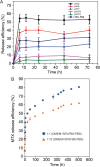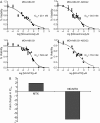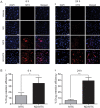Nanodiamond-mitoxantrone complexes enhance drug retention in chemoresistant breast cancer cells
- PMID: 24867631
- PMCID: PMC4216229
- DOI: 10.1021/mp5001108
Nanodiamond-mitoxantrone complexes enhance drug retention in chemoresistant breast cancer cells
Abstract
Chemoresistance is a prevalent issue that accounts for the vast majority of treatment failure outcomes in metastatic cancer. Among the mechanisms of resistance that markedly decrease treatment efficacy, the efflux of drug compounds by ATP-binding cassette (ABC) transporter proteins can impair adequate drug retention by cancer cells required for therapeutic cytotoxic activity. Of note, ABC transporters are capable of effluxing several classes of drugs that are clinical standards, including the anthracyclines such as doxorubicin, as well as anthracenediones such as mitoxantrone. To address this challenge, a spectrum of nanomaterials has been evaluated for improved drug retention and enhanced efficacy. Nanodiamonds (NDs) are emerging as a promising nanomaterial platform because they integrate several important properties into a single agent. These include a uniquely faceted truncated octahedral architecture that enables potent drug binding and dispersibility in water, scalably processed ND particles with uniform diameters of approximately 5 nm, and a demonstrated ability to improve drug tolerance while delaying tumor growth in multiple preclinical models, among others. This work describes a ND-mitoxantrone complex that can be rapidly synthesized and mediates marked improvements in drug efficacy. Comprehensive complex characterization reveals a complex with favorable drug delivery properties that is capable of improving drug retention and efficacy in an MDA-MB-231-luc-D3H2LN (MDA-MB-231) triple negative breast cancer cell line that was lentivirally transduced for resistance against mitoxantrone. Findings from this study support the further evaluation of ND-MTX in preclinical dose escalation and safety studies toward potentially clinical validation.
Figures





Similar articles
-
TTFields alone and in combination with chemotherapeutic agents effectively reduce the viability of MDR cell sub-lines that over-express ABC transporters.BMC Cancer. 2010 May 23;10:229. doi: 10.1186/1471-2407-10-229. BMC Cancer. 2010. PMID: 20492723 Free PMC article.
-
[Regulation mechanism of breast cancer resistance protein by toremifene to reverse BCRP-mediated multidrug resistance in breast cancer cells].Zhonghua Zhong Liu Za Zhi. 2011 Sep;33(9):654-60. Zhonghua Zhong Liu Za Zhi. 2011. PMID: 22340044 Chinese.
-
Evaluation of indomethacin and dexamethasone effects on BCRP-mediated drug resistance in MCF-7 parental and resistant cell lines.Drug Chem Toxicol. 2010 Apr;33(2):113-9. doi: 10.3109/01480540903390000. Drug Chem Toxicol. 2010. PMID: 20307139
-
Multidrug resistance mediated by the breast cancer resistance protein BCRP (ABCG2).Oncogene. 2003 Oct 20;22(47):7340-58. doi: 10.1038/sj.onc.1206938. Oncogene. 2003. PMID: 14576842 Review.
-
Multidrug resistance in cancer chemotherapy and xenobiotic protection mediated by the half ATP-binding cassette transporter ABCG2.Curr Med Chem Anticancer Agents. 2004 Jan;4(1):31-42. doi: 10.2174/1568011043482205. Curr Med Chem Anticancer Agents. 2004. PMID: 14754410 Review.
Cited by
-
Effects of Metallic and Carbon-Based Nanomaterials on Human Pancreatic Cancer Cell Lines AsPC-1 and BxPC-3.Int J Mol Sci. 2021 Nov 9;22(22):12100. doi: 10.3390/ijms222212100. Int J Mol Sci. 2021. PMID: 34829982 Free PMC article.
-
Zonisamide nanodiamonds for brain targeting: A comprehensive study utilising in silico, in vitro, in vivo, and molecular investigation for successful nose-to-brain delivery for epilepsy management.Drug Deliv Transl Res. 2025 Jul 5. doi: 10.1007/s13346-025-01904-x. Online ahead of print. Drug Deliv Transl Res. 2025. PMID: 40617996
-
Nanodiamonds and their potential applications in breast cancer therapy: a narrative review.Drug Deliv Transl Res. 2022 May;12(5):1017-1028. doi: 10.1007/s13346-021-00996-5. Epub 2021 May 10. Drug Deliv Transl Res. 2022. PMID: 33970463 Review.
-
Triple-Negative Breast Cancer: A Review of Conventional and Advanced Therapeutic Strategies.Int J Environ Res Public Health. 2020 Mar 20;17(6):2078. doi: 10.3390/ijerph17062078. Int J Environ Res Public Health. 2020. PMID: 32245065 Free PMC article. Review.
-
Nanodiamonds: The intersection of nanotechnology, drug development, and personalized medicine.Sci Adv. 2015 Aug 21;1(7):e1500439. doi: 10.1126/sciadv.1500439. eCollection 2015 Aug. Sci Adv. 2015. PMID: 26601235 Free PMC article. Review.
References
-
- Siegel R.; Naishadham D.; Jemal A. Cancer Statistics, 2013. CA Cancer J. Clin. 2013, 63, 11–30. - PubMed
-
- Allikmets R.; Gerrard B.; Hutchinson A.; Dean M. Characterization of the Human Abc Superfamily: Isolation and Mapping of 21 New Genes Using the Expressed Sequence Tags Database. Hum. Mol. Genet. 1996, 5, 1649–55. - PubMed
-
- Gottesman M. M.; Pastan I. Biochemistry of Multidrug Resistance Mediated by the Multidrug Transporter. Annu. Rev. Biochem. 1993, 62, 385–427. - PubMed
-
- Muller M.; Meijer C.; Zaman G. J.; Borst P.; Scheper R. J.; Mulder N. H.; de Vries E. G.; Jansen P. L. Overexpression of the Gene Encoding the Multidrug Resistance-Associated Protein Results in Increased Atp-Dependent Glutathione S-Conjugate Transport. Proc. Natl. Acad. Sci. U.S.A. 1994, 91, 13033–7. - PMC - PubMed
-
- Ross D. D.; Yang W.; Abruzzo L. V.; Dalton W. S.; Schneider E.; Lage H.; Dietel M.; Greenberger L.; Cole S. P.; Doyle L. A. Atypical Multidrug Resistance: Breast Cancer Resistance Protein Messenger Rna Expression in Mitoxantrone-Selected Cell Lines. J. Natl. Cancer Inst. 1999, 91, 429–33. - PubMed
Publication types
MeSH terms
Substances
Grants and funding
LinkOut - more resources
Full Text Sources
Other Literature Sources
Miscellaneous

